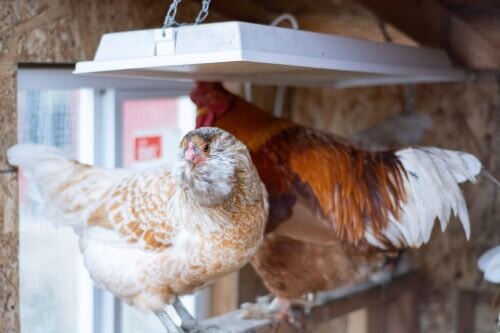6 tips for safely raising chicks in the winter and fall
The best time to buy chicks is typically in the spring—you can find the 9 reasons why in my article, When to buy baby chicks: The simple calculation to find which day is best for you.
However, sometimes you get the itch to buy your chicks in the winter or fall, and you’ve just got to scratch it! But raising winter and fall chicks does come with some extra challenges.
The following 6 tips will ensure you understand these challenges, and that you’re equipped to raise your cold-weather babies safely.
This post contains affiliate links for my favorite products from Amazon. As an Amazon Associate, I earn from qualifying purchases at no extra cost to you.
Tip #1: Buy your chicks locally.
This tip is for those of you who want to order in winter or later in fall when the weather is particularly chilly. Shipping in cold weather can be especially stressful for your chicks. Even if your chicks are shipped in a group as large as 25 chicks, they can chill, resulting in a failure to thrive or even in death.
Additionally, your shipment of chicks may be delayed by bad weather. Chicks can only survive for 72 hours without food and water, so shipment delays are frequently fatal.
So, if you’re able to pick your chicks up from a local hatchery, breeder, or feed store instead, you’ll be setting them up for a much higher chance of survival.
Not sure where to find local breeders and hatcheries? Click on your state below (or neighboring states) to find breeders and hatcheries near you.
Made with Visme Infographic Maker
Tip #2: If you must mail-order your chicks, order from a nearby hatchery.
For the same reasons outlined in Tip #1 above, you’ll want to order cold-weather chicks from a hatchery close to you, rather than from across the country. Your chicks will have a much better chance of surviving shipping if they are only a day away, rather than 2 or 3 days away.
Additionally, if your chick shipment ends up delayed, your chicks will almost certainly die if you order from a hatchery far away that takes a couple of days to ship during the best circumstances. If, on the other hand, you order from a hatchery near you, your chicks may still have a chance.
To find hatcheries near you, click on the states in the map above. You may also want to check out my article, A comparison of top chicken hatcheries that ship nationwide.
HOWEVER—and this is so important—make sure you contact the hatchery before you order to make sure they actually ship from where they’re located. Some hatcheries ship from other states. For example, My Pet Chicken hatchery is located in Connecticut, but they ship at least some of their chicks from Ohio.
Tip #3: Consider ordering a larger number of chicks.
You don’t have to buy a large number of chicks if that’s not good for you. Obviously, if you only want 3 or 4 chicks, you don’t want to buy 20+.
However, the major advantage to buying a larger number of chicks is that they’ll generate a lot more body heat in the brooder as they grow larger. You’ll be able to reduce your auxiliary heat more quickly, but, even more importantly, your chicks will be better able to keep each other warm during their adolescent months in the coop when outside temperatures will be frigid.
This is, of course, something you don’t have to worry about when you raise chicks in the spring as the weather is nice by the time you move them into their permanent coop and run setup.
Tip #4 Make sure you have a lot of space in your brooder or a separate heated grow-out pen.
If you pick up your chicks at the right time in the spring, they’ll be ready to live in your coop and outdoor run at 6 weeks of age. (To learn how to choose the right time, see my article, When to buy baby chicks: The simple calculation to find which day is best for you).
But if you’re raising your chicks in the winter or fall, the weather will be too cold outside for your chicks to be moved to their coop and run at 6 weeks. Instead, you’ll need to keep your chicks in your heated brooder or grow-out pen until they finish their last juvenile molt by about 12 weeks.
And, even then, if your temperatures are particularly low, you’ll want to slowly ease them into those temperatures so they can adapt.
What this means is that you’ll need a lot larger brooding space than you’d need if you were raising your chicks in the spring. By the time your chickens are 12 weeks old, they’ll be quite large, and they’ll need a lot of space.
If you don’t provide your older chicks with a lot of space, they’re likely to be very aggressive with each other. You’ll be tempted to blame this on the pecking order, but this has nothing to do with the pecking order. It’s a management problem that only you can fix.
Make sure you give your chicks plenty of room. A large, heated grow-out pen is infinitely better than a small brooder.
Tip #5: Consider purchasing a Sweeter Heater.
Your chickens will be eternally grateful if you add a Sweeter Heater to their coop. This is a heater that you hang over the roosting bars—it doesn’t heat the coop, but it does heat the space underneath (above the roosting bars). Your chickens will roost under the Sweeter Heater and get some much-needed warmth during the ultra-cold winter nights.
My chickens absolutely LOVE warming up under their Sweeter Heaters. Here, you can see Dolly and Champ on a frigid winter day.
And these heaters prevent comb and wattle frostbite, which are all too common ailments in backyard chickens.
Sweeter Heaters will be especially useful for transitioning your older chicks (~3 months of age) to outdoor temperatures. That little bit of heat will really help them adapt to the cold more comfortably and more safely.
And you can even use them for heat in your brooder!
I use these heaters in all my coops, and I can’t recommend them enough.
Tip #6 You absolutely MUST provide artificial lighting for your hens to develop properly!
This tip may save your hens’ lives.
You may think I’m being hyperbolic, but it’s the truth of it. Most chicken keepers don’t understand that any chicks raised in the off-season (August-March) absolutely require artificial light.
This is because lighting affects the rate of sexual maturity in pullets (female chicks), and if you raise them in winter or fall without added light, they will mature too quickly.
What happens when they mature too quickly? They become highly susceptible to egg binding and vent prolapse, two conditions that can cause serious injury or death.
Below, you can see a YouTube video that shows what these conditions can look like in a hen. Warning—this video is graphic! The hen in this video is suffering from egg binding and prolapse at the same time (an incredibly dangerous combination).
In the video above, the chicken keeper does successfully treat her hen this time. But in a follow-up video, the keeper sadly explains that the same thing happened to her hen again and she had to euthanize her.
To prevent too-early maturity in your female chicks, you need to follow a very specific lighting schedule, which varies depending on your location and the exact time of year you choose to raise your chicks. To learn exactly how to structure your unique lighting schedule, check out my article, Raising chicks in winter or fall? Don’t make this fatal mistake!
Don’t skip this step—your hens will pay the price! You can raise your chicks safely in the off-season, but you’ve got to follow these lighting instructions.
And those are your 6 tips for raising chicks in the winter or fall—I’m wishing you the best of luck!
Pin this article for later!
Sources
Damerow, Gail. Hatching and brooding your own chicks. North Adams: Storey Publishing, 2013.
Damerow, G., The Chicken Health Handbook. North Adams: Storey Publishing, 2015.
Damerow, Gail. Storey’s Guide to Raising Chickens. North Adams: Storey Publishing, 2017.
Ray, S., Swain, P. Amin, R., Nahak, A., Sahoo, S., Rautray, A., and Mishra, A. “Prolapse in laying hens: Its pathophysiology and management: A review.” Indian Journal of Animal Production and Management, v. 29, no. 3-4, 2013, p. 17-24.
Willis, K. and Ludlow, R. Raising Chickens for Dummies. Hoboken: John Wiley & Sons, Inc., 2020.


